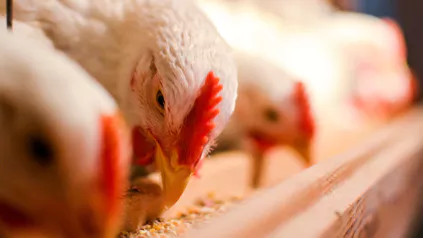


The Importance of Particle Size in Broiler Diets
Jul 19, 2025
The most used raw materials in poultry feed are maize, wheat and soy. Chickens do not have teeth to grind these materials. They have a muscular stomach called the gizzard, which uses grit to grind the feed into smaller, more digestible particles. The particle size of broiler feed is of great importance for the feed intake and growth of broilers and therefore needs special attention during the production of broiler feeds. Both fine and coarse grinding have advantages and disadvantages, so finding the optimal particle size can be challenging, but it is very important to optimise production. Although changing the particle size can incur costs, this can be compensated by the improved performance when feeding the optimal particle size.
If the particles, especially in mash diets, are too coarse or not homogenous in size, it is easier for the broiler to select the most preferred raw material. As a result some raw materials, such as maize, are eaten better than others and therefore the broilers do not get all the nutrients they need for optimal growth. In mash diets the particle homogeneity can be easily assessed by taking a sample of the feed and checking that all particles are approximately the same size. When pellets are fed, homogeneity can be assessed by dissolving some pellets in water using a transparent container. After 30 minutes of settling, the different layers of the coarse and fine particles can be seen.
When the feed is finely ground, the digestive enzymes have a larger substrate surface to work on, which is thought to improve digestion and absorption. Smaller particles are especially important for young chicks, whose gizzard is not fully developed and are therefore unable to break down large grains. Also, in the first days chicks have difficulties in swallowing large particles. As a result, the growth in chicks is affected when particles are too coarse. However, if the feed is too finely ground, the digesta becomes very fluid, which increases the risk of coccidiosis. If the digesta is fluid, the gizzard has less work to do in grinding, resulting in an underdeveloped gizzard. Also, the transit time through the intestines is shorter with finely ground feed. When feeding more coarse particles, the transit time trough the intestines will be longer, which gives more time to digest and absorb the nutrients. The physical stimulus of coarse particles also increases the absorption surface in the intestine and develops the intestinal flora, and thereby better repels potential pathogens.
To conclude, the optimal particle size depends on the age of the broiler. Young chicks can better ingest and digest fine feed particles. As the broiler gets older and its digestive system is more developed, coarser ground feed can be given to stimulate gizzard function. Feed that is ground too fine or too coarse is both detrimental, therefore the optimum particle size for broiler feed based on maize or sorghum is between 600 and 900 μm (geometric mean diameter). Also, it is always important that the particle size is uniform in order to avoid selection and to obtain optimal production.








